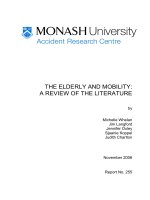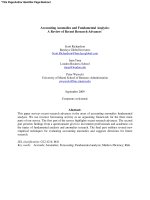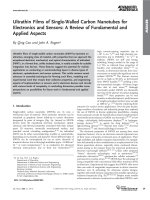erk in learning and memory a review of recent research
Bạn đang xem bản rút gọn của tài liệu. Xem và tải ngay bản đầy đủ của tài liệu tại đây (208.18 KB, 11 trang )
Int. J. Mol. Sci. 2010, 11, 222-232; doi:10.3390/ijms11010222
OPEN ACCESS
InterNational Journal of
Molecular Sciences
ISSN 1422-0067
www.mdpi.com/journal/ijms
Review
ERK in Learning and Memory: A Review of Recent Research
Sheng Peng, Yan Zhang *, Jiannan Zhang, Hua Wang and Bingxu Ren
Department of Anesthesiology, Affiliated No.4 Hospital of Soochow University, Wuxi, 214062,
China; E-Mails: (P.S.); (J.Z.);
(H.W.); (B.R.)
* Author to whom correspondence should be addressed; E-Mail: ;
Tel.: +86-510-8868-2999; Fax: +86-510-8868-2999.
Received: 16 December 2009; in revised form: 8 January 2010 / Accepted: 10 January 2010 /
Published: 13 January 2010
Abstract: The extracellular signal-regulated kinase (ERK) pathway is a member of the
mitogen-activated protein kinase (MAPK) superfamily, which is an important, highly
conserved family of enzymes associated with cell membrane receptors and regulative
targets. In the central nervous system, there is almost no mature neuronal proliferation and
differentiation, but the regulation of MAPK and its upstream and downstream molecular
pathways is still widespread, with the ERK signaling pathway being one of the most
actively studied signal transduction pathways. It is activated by a variety of cell growth
factors and substances which promote mitotic activity, and transmits extracellular signals
from the cell surface to the nucleus, which transmission plays an important role in the
process of cell proliferation and differentiation. In recent years, accumulating evidence has
shown that the ERK signaling pathway has an important link with the higher functions of
learning and memory.
Keywords: ERK; learning and memory; neurobiology
1. Introduction
Learning and memory are high-level brain functions, and they constitute an area of rapid advances
in the field of neurobiology. At present, the neurobiology of learning and memory is largely focused
on the high degree of plasticity in the central nervous system, especially synaptic plasticity and its
functions. Synapses are a critically important structure for the transmission of information between
Int. J. Mol. Sci. 2010, 11
223
neurons. Under certain conditions, the effectiveness of synaptic transmission depends upon
morphological change to modify biological function. The process of central excitatory synaptic
transmission, including both long-term potentiation (LTP) and long-term depression (LTD), is a wellknown model for neural synaptic plasticity research.
The extracellular signal-regulated kinase (ERK) pathway belongs to the mitogen-activated protein
kinase (MAPK) superfamily, which is an important, highly conserved family of enzymes associated
with cell membrane receptors and regulative targets. In the central nervous system, there is almost no
mature neuronal proliferation and/or diferentiation, but the regulation of MAPK and its upstream and
downstream molecular effectors is still widespread. The ERK signaling pathway is one of the most
actively studied these signal transduction pathways. It is activated by a variety of cell growth factors
and substances promoting mitotic activity, and transmits extracellular signals from the cell surface to
the nucleus, which transmission plays an imortant role in the process of cell proliferation and
differentiation. In recent years, accumulating evidence has shown that the ERK signaling pathway has
an important link with the functions of learning and memory [1–4].
2. ERK in Learning and Memory
2.1. ERK
The MAPK cascade signaling pathway is a critically important cell-mediated response. The
composition of the MAPK pathway and its upstream regulating kinase form a functional unit, serving
as a bridge between the upstream input signal and a wide variety of output signals. The functional unit
is composed of three kinds of kinases, MAPK kinase kinase (MKKK), MAPK kinase (MKK), MAPK.
These allow a series of kinase cascades which constitute a module for the activation of the three
components. The module from yeast to humans is very highly conserved. MKKK is a serine/threonine
kinase, and it effects the phosphorylation of MKK when it is activated; MKK is a dual specificity
kinase that recognizes and phosphorylates threonine-X-tyrosine (Thr-X-Tyr) MAPK activity. It
activates the Thr-X-Tyr sequence, in which X can be any of the eukaryotic amino acids. MAPK is the
last kinase of the activated three-component module, and the MAPK phosphorylation site is the
substrate of the serine and threonine residues. The MAPK pathways in mammalian cells is divided,
based on the different Thr-X-Tyr sequences, into the ERK, c-Jun N-terminal kinase (c-Jun N-terminal
kinase, JNK)/stress-activated protein kinase (stress actived protein kinase, SAPK), p38MAPK and
ERK5/BMK1 (big MAP kinase1) subfamily. The above MAPKs in the protein kinase VIII subfamily
of the threonine and tyrosine sites activate different motifs. ERK is a threonine-glutamic acid-tyrosine
(Thr-Glu-Tyr) motif [5,6]. ERK is divided into two subtypes: ERK1 and ERK2.
It is generally believed that the activation of ERK signaling takes place via the following four
pathways [7–10]: (1) Receptor tyrosine kinase stimulation of Ras activation: growth factor → receptor
tyrosine kinase → Ras → MAPKKK → MAPKK → ERK. (2) Ca2+ stimulated Ras activation: Ca2+
activates Ras by various mechanisms. Ca2+ flows into the cells through the L-type voltage-dependent
calcium channel, and through the Src-mediated protein kinase family, leading to the phosphorylation
of the epidermal growth factor (EGF) receptor tyrosine kinase, and further activation of Ras through
the Shc-Grb-Sos complex. (3) Protein Kinase C (PKC) activation of the ERK pathway: PKC regulates
the activity of ERK isozymes by different mechanisms, and this regulation is specific to cell type. The
Int. J. Mol. Sci. 2010, 11
224
PKC agonist phorbol esters stimulate T cells and B cells, which can activate ERK. This is
Ras-dependent, but activation of ERK in fibroblasts with phorbol esters is Ras-independent.
(4) G protein-coupled receptor activation of the ERK pathway: guanine nucleotide binding
protein (G protein)-coupled receptors activation of ERK through both Ras-dependent and Rasindependent pathways.
2.2. ERK with LTP and Synaptic Plasticity
It is generally accepted that long-term potentiation (LTP) is one of the cellular mechanisms
involved in learning and memory. In 1997, England found that the application of the MEK inhibitor
PD98059 inhibited hippocampal LTP, the first evidence of a role of ERK signaling in synaptic
plasticity. In 2001, Dicristo and his collegues [11] reported that the participation of cortical neurons in
the LTP pathway also requires the activation of ERK. Subsequenty Gooney et al. [12] observed that
brain-derived neurotrophic factor (BDNF) = induced LTP also requires the activation of ERK. A
number of behavioral experiments further confirmed that ERK is involved in the process of learning
and memory. Blum et al. [13] reported that water maze training in mice can lead to the activation of
ERK in the hippocampus. Selcher et al. [14] reported that PD98095 administered by injection into the
mouse hippocampus or systemic drug delivery, led to the weakening of memory in animals by the
activation of the inhibitor SL327 and of the blood-brain barrier potent ERK. In an offensive odor
avoidance experiment, Bearman et al . [15] observed that the ability of rats to learn a new odor
associated with the avoidance response was weakened by MEK blockers. Selcher et al. [16] found that
starting from 1 on the frequency of 100 Hz induced by tetanic stimulation induced LTP, which
required the activation of ERK in rats, but not mice. However, an ERK inhibitor blocked endogenous θ
wave generation of LTP in these animals. The above experimental results show that ERK activation,
LTP and learning and memory have close links with each other.
Recent investigation has demonstrated that the Ras/ERK pathways are involved in the processes of
human cognition. Silva et al . [17] found learning decrements to be closely related to deficits in the
Ras/ERK signaling pathway in an investigation of the relationship between neurofibromatosis type I
blastoma (NF1) and mental retardation that was conducted utilizing genetic engineering technology.
The NF1 gene product is the neurofibromatosis protein (neurofibromin), a multi-domain molecule
regulating a variety of intracellular pathways, which can activate the ERK pathway by means of Ras
GTP synthase. Following the genetic NF1 mutation in certain types of nerve fiber blastoma, GAP is
compromised, resulting in excessive Ras activity in the hippocampus, causing the Ras/ERK pathway
to become further over-excited, resulting in a decrease of learning and memory [18,19].
Costa et al . [20] also reported that precise neurofibroma protein regulation and control of Ras is
necessary for cognition, and that NF1 gene mutation in mice caused a partial deficiency of the
neurofibromatosis protein such that the activity of Ras was significantly increased, with the result that
the inhibitory function of the GABA-mediated signal was abnormally enhanced, which can directly
damage synaptic plasticity, thus giving rise to learning deficits.
Int. J. Mol. Sci. 2010, 11
225
2.3. The Impact of ERK on the Nuclear Transcription Factors Involved in LTP and Synaptic Plasticity
In a similar manner as observed in non-nerve cells, the activation of ERK in mature neurons results
in a translocation from the cytoplasm into the nucleus [21,22], suggesting that the regulation of
transcription factors may be one of the roles of the ERK signaling system. Davis, et al. [23] found that
LTP in the process of the dentate gyrus of the hippocampus was induced along with the
phosphorylation of the transcription and activation of the transcription factor Elk1 was sensitive to a
MAPK/ERK kinase inhibitor. In a study of invertebrates and rodents, Lonze et al. [24] found that the
transcription factor CREB has an important impact on various forms of learning and memory.
Shaywitz, et al . [25] reported that the phosphorylation of the Ser133 residue of cAMP response
element binding (CREB) had an impact on the regulation of gene transcription.
Hardingham et al . [26] found that MAPK/ERK kinase inhibitors block the sustained
phosphorylation of CREB residue Ser133 and exert an effect the process of the CREB-dependent
transcription, suggesting that ERK has a role in the regulation of CREB activity. Xing et al. [27] have
shown that RSKs (ribosomal protein S6 kinases) and MSKs (mitogen and stress-activated protein
kinases) downstream of ERK induced CREB-Ser133 as part of its substrate in vitro. Trivier et al. [28]
found that RSK2 gene mutations induce learning deficits in mice and humans. The above results
suggest that ERK plays a regulatory role in the process of LTP, as well as learning and memory,
through the activity of certain nuclear transcription factors.
2.4. ERK along with LTP and Synaptic Plasticity Are Related to the Protein Translation
From the time course data, LTP can be divided into different phases utilizing different molecular
mechanisms, respectively. The first approximate 30 min is termed short-term potentiation (STP). This
stage is suggested to be related to the processes of resting receptors on the postsynaptic membrane, and
to have nothing to do with the role of protein kinases. The next 1–2 h is known as E-LTP (early-LTP),
and is closely related to the role of protein kinase phosphorylation of the receptor, such as the CaMK II
effect on the α-amino-3-hydroxy-5-methyl-4-isoxazolepropionic acid (AMPA) receptor. The L-LTP
(late-LTP) phase requires new protein synthesis, as well as the involvement of PKA. Studies have
found that the ERK signaling system has an effect on not only postsynaptic receptors and
nucleoprotein-related transcription factors, but also a regulatory effect on LTP through translation of
the protein [29–31].
Kelleher et al. [32] observed a learning and memory association of MAPK and synaptic plasticity
with the effects of protein synthesis in dnMEK1 mice (dominant-negative MEK1 mice). This dnMEK1
mouse lacks the activity of mitogen-activated protein kinase 1 (MEK1) kinase, but retains the capacity
for the combiNation with ERK1/2. In a study of LTP in hippocampal slices, it was found that synaptic
transmission and the function of E-LTP were normal, but L-LTP was selectively weakened. This may
be because the phosphorylation levels of the protein translation of the initiation factor in the
hippocampal neurons had been reduced, thus weakening the selective formation of LTP involved in
protein synthesis.
In the initiation of protein translation, the initiation factor elF4E recognizes the mRNA 5' terminal
cap structure, followed by the combiNation of the elF4G subunit with ribosomal 40S. This process is
considered to be a key initial step. eIF4E phosphorylation and the elF4E inhibitor 4E-BP1 modify the
Int. J. Mol. Sci. 2010, 11
226
ability of elF4E to recognize the mRNA 5 'terminal cap structure and also the binding with elF4G.
Kelleher et al. [32] found the elF4E and S6 ribosomal proteins to be highly dependent on the form of
ERK phosphorylation, and similar structures involved in the process of the elF4E and S6 ribosomal
protein phosphorylation in the case of hippocampal LTP also require the activity of ERK. This
suggests that ERK plays an important role in the formation and maintenance of LTP at the protein
translation level.
The θ frequency stimulation can mimic rodent hippocampal CA1 neuronal discharge patterns in the
learning environment. It reportedly induces the action potential in the hippocampal CA1 region, and
then backpropagates to dendritic synapses, resulting in the depolarization. Winder et al. [22] found that
a block of ERK activation in rat hippocampal CA1 inhibited θ frequency stimulation-induced LTP.
Winder et al . [33] found that the θ frequency stimulation which induced LTP by the β-adrenergic
receptor was also inhibited by ERK activation blockers. Gelinas et al. [34] observed hippocampal CA1
area-induced L-LTP when β-adrenergic receptor activation and subthreshold electrical stimulation was
applied. In this case, only the translation and synthesis of the new protein was observed at the dendritic
sites, not transcription in the cell body, and this form of LTP also requires the activation of ERK. The
above study also suggested a key role LTP in association with protein synthesis.
2.5. ERK Affect on NMDA and AMPA Receptors
In the course of LTP induction, the (N-methyl-D-aspartate) NMDA receptor and Ca2+ play a critical
role. After the Voltage-ligand-gated NMDA receptor is activated, it mediates Ca2+ entry into the cell
and activates a number of biochemical pathways. It also triggers a series of reactions which result in
the increase of synaptic responses and the formation of LTP. The activation of the NMDA receptor is a
key step in NMDA receptor-dependent hippocampal LTP induction, and the depolarization of
postsynaptic membrane is one of the necessary conditions for the activation of the NMDA receptor.
PKA, PKC, and β-adrenergic receptor activators regulate the neuronal dendritic K+ channel through
the activation of ERK, and the Kv4 family of dendritic voltage-dependent K+ channels controls the
degree of the synaptic depolarization by regulating the depolarization levels of their cell membranes,
which further affects the induced NMDA receptor-dependent LTP [35,36]. The activation of ERK
leads to the phosphorylation of the K+ channel α-subunit of the Kv4 family, which apparently changes
the K+ channels from being voltage-dependent to depolarization-dependent. This increases the
excitatory state of the synaptic membrane and opens the K+ channels, leading to an even stronger
depolarization. Increase in the excitability of the membrane results in a stronger postsynaptic
membrane depolarization mediated by the AMPA receptor-inward current, and ultimately leads to the
activation of NMDA receptors [37,38]. This depolarization affects other synaptic neurons, such that
LTP is facilitated. An increase in the number of AMPA-type glutamate receptors in the postsynaptic
membrane and enhancement of receptor activity play an important role in the process of LTP
generation. Some synapses in the resting state exhibit only an NMDA receptor reaction, not a reaction
of the AMPA receptor. When LTP is induced or CaMK II activated, the AMPA receptor appears in the
postsynaptic membrane, so that the effectiveness of synaptic transmission is evidently increased. In a
study of LTP induction and maintenance in hippocampal slices, Zhu et al. [39] observed a relationship
between the Ras-ERK cascade signaling pathway and the AMPA receptor, and also with synaptic
Int. J. Mol. Sci. 2010, 11
227
plasticity, through the activation of recombinant AMPA receptors. Their results showed that the
activity of Ras increased the response of synaptic AMPA receptors, and this effect was blocked by the
MAPK/ERK kinase inhibitor PD98095, suggesting that the ERK activation in this process is
associated with the activity of the AMPA receptor. In addition, the activation of CaMK II mediation of
the enhanced AMPA receptor was equally sensitive to PD98095, suggesting that ERK plays a
regulatory role in the process of the CaMK II-mediated AMPA receptor insertion into the postsynaptic
membrane. Hence, it is speculated that the role of CaMK II in hippocampal LTP may be effected
through Ras proteins, and thus lead to ERK activation. The AMPA receptor insertion into the
postsynaptic membrane would be likely to increase the size of the dendritic spines or to induce the
development of new pseudopods (filopodia) and dendritic spines, thereby enhancing the effectiveness
of synaptic transmission. As the neuronal dendrites comprise 90% of the total surface area, changes in
the dendrite number, length and cross-sectional area are closely related with changes in brain function.
It is reported that the MEK inhibitor U0126 not only blocks the LTP of hippocampal neurons in vitro,
it also blocks the formation of new dendritic spines and pseudopods [40,41]. These results suggest that
ERK affects the morphology of synaptic plasticity in the regulation of the insertion of the AMPA
receptor into the postsynaptic membrane, and furthermore, plays a regulatory role in neural synaptic
transmission [42].
2.6. The ERK Pathway and Long-Term Memory
In a study by Kelly et al . [43], DMSO (control group) and the MAPK/ERK inhibitor UO126
(experimental group) were injected into the ventricle of SD rats. The use of behavior monitoring
methods revealed that the time spent searching for new and old targets after 40 minutes of training was
not significantly different between the groups (P > 0.05). However, on the second day, the time
required by the experimental group to find both new and old targets was significantly longer than the
control group (P < 0.01). The results showed that there was an effect on the maintenance of long-term
memory and that the learning function was blocked, but there was no significant effect on short-term
memory by the administration of UO126 in rats. Mazzucchelli et al . [44] observed that ERK1
knockout in the striatum affected both learning and memory in a study of one-trial passive avoidance
behavior in mice. The results showed that ERK1 knockout mice did not exhibit an affect after the first
30 minutes of training, but after the first 24 hours of training, in the knockout mice the memory was
enhanced, and the avoidance before entry into the dark was significantly prolonged (P < 0.01). These
results suggest that long-term memory function was significantly improved and short-term memory
retained in the ERK1 knockout mice. Zhang et al . [45] found that PD98059 damaged olfactory
function as well as learning and memory in young rats after injection into the olfactory bulb in rats, but
this did not affect the memory displayed after 1 h of training. Western blot analysis confirmed that the
phosphorylation of ERK1 and ERK2 was significantly increased after odor shock training for 1h in
normal rats, and thus activated the ERK pathway, and PD98059 significantly decreased the levels of
ERK phosphorylation, which affected the function of learning and memory in rats.
Int. J. Mol. Sci. 2010, 11
228
2.7. ERK Signaling Pathway with Other Pathways of Interation
The crucial functions of learning and memory are associated with complex physiological and
biochemical mechanisms, including the ERK pathway, in association with a number of other signal
transduction pathways. Studies have confirmed that certain learning and memory functions are
associated with interactions among the GABA pathway, ERK, the cholinergic signaling pathway and
their reciprocal interactions. The generation of LTP usually requires the activation of the NMDA
receptor, with this process mainly regulated by the Kv4-encoded A-type potassium ion channel family
members [46]. Yuan and Morozov et al . [47,48] found that the activation of the hippocampal CA1
β-adrenergic receptor, as well as the PKA and PKC activation cascades, induced the phosphorylation
of Kv4.2α subunit by the activation of ERK, a process which was blocked by the ERK inhibitor
UO126 or PD98059. The phosphorylation of Kv4.2 α caused a reduction of the A-type K+ current, and
induced amplification of the action potential (AP), and thereby enhanced the excitability of the
dendritic membrane. Studies have also reported that after blocking the MAPK/ERK pathway with
ERK inhibitors, the activation of the β-adrenergic and cholinergic receptors, which induce the
formation of LTP, was inhibited, and the generation of LTP with 5 Hz of electrical stimulation was
also inhibited [49]. In the latest report by Watanabe et al . [50], dendritic membrane potassium
channels were shown to be regulated by the PKA and PKC signaling cascades as well as β-adrenergic
receptor activation, and this regulation depended on the activation of ERK. In addition, PKA-induced
Rap-1 binding with B-Raf, which led to the phosphorylation of MAPK/ERK and the activation of
cAMP response element binding protein (CREB), which participated in the formation of
PKA-dependent LTP and the changes of synaptic plasticity [51]. In a study of the relationship between
histone acetyltransferase (HAT) and learning and memory [52], Swank and his colleagues found that
the ERK cascade pathway regulated the acetylation of a 42KD substrate of lysine acetyltransferase,
indicating that there is a causal relationship between the activation of ERK and HAT activity in the
cerebral cortex.
3. Conclusions
The MAPK cascade signaling pathway is of critical importance in a broad variety of cells. It
responds to a wide range of extracellular stimuli, and is a major mechanism by which extracellular
signals are transduced in the cell. The activation of ERK1/ERK2 regulates synaptic proteins and
promotes the formation of new dendritic spines. It also has an impact on the phosphorylation status of
nuclear transcription and translation factors related to LTP and synaptic plasticity, and plays a positive
regulatory role in the induction and maintenance of LTP. Various studies have demonstrated a number
of pathways which participate in the induction and maintenance of LTP, but a clear and detailed
description of the interaction between the various signaling pathways and the regulation of LTP awaits
further investigation.
Int. J. Mol. Sci. 2010, 11
229
Acknowledgements
This work was financially supported by the Grants from the Medical Scientific Research
Foundation of Jiangsu Province, China (Grant No. H200645) and the Science Foundation of the Health
Bureau. Wuxi City, China (Grant No. XM0805).
References and Notes
1.
2.
3.
4.
5.
6.
7.
8.
9.
10.
11.
12.
13.
14.
15.
Sweatt, J.D. Motigen-activated protein kinases in synaptic plasticity and memory. Curr. Opin .
Neurobiol. 2004, 14, 311–317.
Ji, R.R.; Gereau, R.W.; Malcangio, M.; Strichartz, G.R. MAP kinase and pain. Brain Res. Rev.
2009, 60, 135–148.
Feld, M.; Dimant, B.; Delorenzi, A.; Coso, O.; Romano, A. Phosphorylation of extra-nuclear
ERK/MAPK is required for long-term memory consolidation in the crab ChasmagNathus.
Behavioural. Brain Res. 2005, 158, 251–261.
Giovannini, M.G. The role of the extracellular signal-regulated kinase pathway in memory
encoding. Rev. Neurosci. 2006, 17, 619–634.
Hunter, T. Signaling -2000 and beyond. Cell 2000, 100, 113–127.
Liu, Y.; Formisano, L.; Savtchouk, I.; Takayasu, Y.; Szabó, G.; Zukin, R.S.; Liu, S.J. A single
fear-inducing stimulus induces a transcription-dependent switch in synaptic AMPAR phenotype.
Nat. Neurosci. 2009, doi:10.1038/nn.2474.
Cullen, P.J.; Lockyer, P.J. Intergration of calcium and Ras signaling. Nat. Rev Mol. Ce ll Bi ol.
2002, 3, 339–348.
Eisinger, D.A.; Ammer, H. Delta-opioid receptors activate ERK/MAP kinase via integrinstimulated receptor tyrosine kinases. Cell Signal. 2008, 20, 2324–2331.
Gao, L.; Chao, L.; Chao, J. A novel signaling pathway of tissue kallikrein in promoting
keratinocyte migration: Activation of proteinase-activated receptor 1 and epidermal growth factor
receptor. Exp. Cell Res. 2009, 316, 376–389.
English, J.D.; Sweatt, J.D. A requirement for the mitogen-activated protein kinasecascade in
hippocampal long term potentiation. J. Biol. Chem. 1997, 272, 19103–19106.
Di Cristo, G.; Berardi, N.; Cancedda, L.; Pizzorusso, T.; Putignano, E.; Ratto, G.M.; Maffei, L.
Requirement for ERK activation for visual cortical plasticity. Science 2001, 292, 2337–2340.
Gooney, M.; Messaoudi, E.; Maher, F.O.; Bramham, C.R.; Lynch, M.A. BDNF-induced LTP in
dentate gyrus is impaired with age: analysis of changes in cell signaling events. Neurobiol. Aging
2004, 25, 1323–1331.
Blum, S.; Moore, A.N.; Adams, F.; Dash, P.K. A mitogen-activated protein kinase Cascade in the
CA1/CA2 subfield of the dorsal hippocampus is essential for long-term spatial memory.
J. Neurosci. 1999, 19, 3535–3544.
Selcher, J.C.; Atkins, C.M.; Trzaskos, J.M.; Paylor, R.; Sweatt, J.D. A necessity for MAP kinase
activation in mammalian spatial learning. Learn Mem. 1999, 6, 478–490.
Berman, D.E.; Hazvi, S.; Rosenblum, K.; Seger, R.; Dudai, Y. Specific and differential activation
of mitogen-activated protein kinase cascades by unfamiliar taste in the insular cortex of the
behaving rat. J. Neurosci. 1998, 18, 10037–10044.
Int. J. Mol. Sci. 2010, 11
230
16. Selcher, J.C.; Weeber, E.J.; Christian, J.; Nekrasova, T.; Landreth, G.E.; Sweatt, J.D. A role for
ERK MAP kinase in physiologic temporal integration in hippocampal area CA1. Learn Mem.
2003, 10, 26–39.
17. Silva, A.J.; Frankland, P.W.; Marowitz, Z.; Friedman, E.; Laszlo, G.S.; Cioffi, D.; Jacks, T.;
Bourtchuladze, R. A mouse model for the learning and memory deficits associated with
neurofibromatosis type I. Nat. Genet. 1997, 15, 281–284.
18. Denayer, E.; Ahmed, T.; Brems, H.; van Woerden, G.; Borgesius, N.Z.; Callaerts-Vegh, Z.;
Yoshimura, A.; Hartmann, D.; Elgersma, Y.; D'Hooge, R.; Legius, E.; Balschun, D. Spred1 is
required for synaptic plasticity and hippocampus-dependent learning. J. Neurosci. 2008, 28,
14443–14449.
19. Cotman, C.W. The role of neurotrophins in brain aging: a perspective in honor of Regino PerezPolo. Neurochem. Res. 2005, 30, 877–881.
20. Costa, R.M.; Yang, T.; Huynh, D.P.; Pulst, S.M.; Viskochil, D.H.; Silva, A.J.; Brannan, C.I.
Learning deficits, but normal development and tumor predisposition, in mice lacking exon 23 a of
Nf1. Nat. Genet. 2001, 27, 399–405.
21. Acquas, E.; Vinci, S.; Ibba, F.; Spiga, S.; De Luca, M.A.; Di Chiara, G. Role of dopamine D(1)
receptors in caffeine-mediated ERK phosphorylation in the rat brain. Synapse 2009, 64, 341–349.
22. Patterson, S.L.; Pittenger, C.; Morozov, A.; Martin, K.C.; Scanlin, H.; Drake, C.; Kandel, E.R.
Some forms of cAMP-mediated long lasting potentiation are associated with release of BDNF and
nuclear translocation of phosphor-MAP kinase. Neuron 2001, 32, 123–140.
23. Davis, S.; Vanhoutte, P.; Pages, C.; Caboche, J.; Laroche, S. The MAPK/ERK cascade targets
both Elk-1 and camp response element-binding protein to control long-term potentiationdependent gene expression in the dentate gyrus in vivo. J. Neurosci. 2000, 20, 4563–4572.
24. Lonze, B.E.; Ginty, D.D. Function and regulation of CREB family transcription factors in the
nervous system. Neuron 2002, 35, 605–623.
25. Hardingham, G.E.; Arnold, F.J.; Bading, H.A. calcium microdomain near NMDA receptors: on
switch for ERK dependent synapse-to-nucleus communication. Nat. Neurosci. 2001, 4, 565–566.
26. Shaywitz, A.J.; Greenbe, M.E. CREB: a stimulus-induced transcription factor activated by a
diverse array of extracellular signals. ANNU Rev. Biochem. 1999, 68, 821–861.
27. Xing, J.; Kornhauser, J.M.; Xia, Z.; Thiele, E.A.; Greenberg, M.E. Nerve growth factor activates
extracellular signal-regulated kinase and p38 mitogen-activated protein kinase pathways to
stimulate CREB serine 133 phosphorylation. Mol. Cell Biol. 1998, 18, 1946–1955.
28. Trivier, E.; De Cesare, D.; Jacquot, S.; Pannetier, S.; Zackai, E.; Young, I.; Mandel, J.L.; SassoneCorsi, P.; Hanauer, A. Mutations in the kinase RSK-2 associated with Coffin-Lowry Syndrome.
Nature 1996, 384, 567–570.
29. Toyoda, H, Zhao, M.G.; Ulzhöfer, B.; Wu, L.J.; Xu, H.; Seeburg, P.H.; Sprengel, R.; Kuner, R.;
Zhuo, M. Roles of the AMPA receptor subunit GluA1 but not GluA2 in synaptic potentiation and
activation of ERK in the anterior cingulate cortex. Mol. Pain. 2009, 5, doi: 10.1186/1744-8069-5-46.
30. Li, W.; Keifer, J. CoordiNate action of pre- and postsynaptic brain-derived neurotrophic factor is
required for AMPAR trafficking and acquisition of in vitro classical conditioning. Neuroscience
2008, 155, 686–697.
Int. J. Mol. Sci. 2010, 11
231
31. Giralt, A.; Rodrigo, T.; Martín, E.D.; Gonzalez, J.R.; Milà, M.; Ca, V.; Dierssen, M.; Canals,
J.M.; Alberch, J. Brain-derived neurotrophic factor modulates the severity of cognitive alterations
induced by mutant huntingtin: involvement of phospholipaseCgamma activity and glutamate
receptor expression. Neuroscience 2009, 158, 1234–1250.
32. Kelleher, R.J.; Govindarajan, A.; Jung, H.Y. Translational control by MAPK sinaling in long-term
synaptic plasticity and memory. Cell 2004, 116, 467–479.
33. Winder, D.G.; Martin, K.C.; Muzzio, I.A.; Rohrer, D.; Chruscinski, A.; Kobilka, B.; Kandel, E.R.
ERK plags a regulatory role in induction of LTP by theta frequency stimulation and its
modulation by beta-adrenergic receptors. Neuron 1999, 24, 715–726.
34. Gelinas, J.N.; Nguyen, P.V. Beta-adrenergic receptor activation facilitates induction of a protein
synthesis-dependent late phase of long-term potentiation. J. Neurosci. 2005, 25, 3294–3303.
35. Birnbaum, S.G.; Varga, A.W.; Yuan, L.L.; Anderson, A.E.; Sweatt, J.D.; Schrader, L.A. Structure
and function of Kv4-family transient potassium channels. Physiol. Rev. 2004, 84, 803–833.
36. Gorkiewicz, T.; Szczuraszek, K.; Wyrembek, P.; Michaluk, P.; Kaczmarek, L.; Mozrzymas, J.W.
Matrix metalloproteinase-9 reversibly affects the time course of NMDA-induced currents in
cultured rat hippocampal neurons. Hippocampus 2009, doi:10.1002/hipo.20736.
37. Watanabe, S.; Hoffman, D.A.; Migliore, M.; Johnston, D. Dendritic K+ channels contribute to
spike-timing dependent long-term potentiation in hippocampal pyramidal neurons. Proc. Nat.
Acad. Sci. 2002, 12, 8366–8371.
38. Moult, P.R.; Corrêa, S.A.; Collingridge, G.L.; Fitzjohn, S.M.; Bashir, Z.I. Co-activation of p38
mitogen-activated protein kinase and protein tyrosine phosphatase underlies metabotropic
glutamate receptor-dependent long-term depression. J. Physiol. 2008, 15, 2499–2510.
39. Zhu, J.J.; Qin, Y.; Zhao, M.; van Aelst, L.; Malinow, R. Ras and Rap control AMPA receptor
trafficking during synaptic plasticity. Cell 2002, 110, 443–455.
40. Wu, G.Y.; Deisseroth, K.; Tsien, R.W. Spaced stimuli stabilize MAPK pathway activation and its
effects on dendritic morphology. Nat. Neurosci. 2001, 4, 151–158.
41. Goldin, M.; Segal, M. Protein kinase C and ERK involvement in dendritic spine plasticity in
cultured rodent hippocampal neurons. Eur. J. Neurosci. 2003, 17, 2529–2539.
42. Zadran, S.; Qin, Q.; Bi, X.; Zadran, H.; Kim, Y.; Foy, M.R.; Thompson, R.; Baudry, M. 17{beta}-Estradiol increases neuronal excitability through MAP kinase-induced calpain activation.
Proc. Nat. Acad. Sci. USA 2009, 106, 21936–21941.
43. Kelly, A.; Laroche, S.; Davis, S. Activation of mitogen-activated protein kinase/extracellular
signal-regulated kinase in hippocampal circuitry is required for consolidation and reconsolidation
of recognition memory. J. Neurosci. 2003, 23, 5354–5360.
44. Mazzucchelli, C.; Vantaggiato, C.; Ciamei, A.; Fasano, S.; Pakhotin, P.; Krezel, W.; Welzl, H.;
Wolfer, D.P.; Pagès, G.; Valverde, O.; Marowsky, A.; Porrazzo, A.; Orban, P.C.; Maldonado, R.;
Ehrengruber, M.U.; Cestari, V.; Lipp, H.P.; Chapman, P.F.; Pouysségur, J.; Brambilla, R.
Knockout of ERK1 MAP kinase enhances synaptic plasticity in the striatum and facilitates
striatal-mediated learning and memory. Neuron 2002, 34, 807–820.
Int. J. Mol. Sci. 2010, 11
232
45. Zhang, J.J.; Okutani, F.; Inoue, S.; Kaba, H. Activation of the mitogen-activated protein
kinase/extracellular signal-regulated kinase signaling pathway leading to cyclic AMP response
element binding protein phosphorylation is required for the long-term facilitation process of
aversive olfactory learning in young rats. Neuroscience 2003, 121, 9–16.
46. Birnbaum, S.G.; Varga, A.W.; Yuan, L.L.; Anderson, A.E.; Sweatt, J.D.; Schrader, L.A. Structure
and function of Kv4-family transient potassium channels. Physiol. Rev. 2004, 84, 803–833.
47. Yuan, L.L.; Adams, J.P.; Swank, M.; Sweatt, J.D.; Johnston, D. Protein kinase modulation of
dendritic K+ channels in hippocampus involves a mitogen-activated protein kinase pathway.
J. Neurosci. 2002, 22, 4860–4868.
48. Morozov, A.; Muzzio, I.A.; Bourtchouladze, R.; van Strien, N.; Lapidus, K.; Yin, D.; Winder,
D.G.; Adams, J.P.; Sweatt, J.D.; Kandel, E.R. Rap1 couples cAMP signaling to a distinct pool of
p42/44 MAPK regulating excitability, synaptic plasticity, learning, and memory. Neuron 2003,
39, 309–325.
49. Watabe, A.M.; Zaki, P.A.; O'Dell, T.J. Coactivation of beta-adrenergic and cholinergic receptors
enhances the induction of long-term potentiation and synergistically activates mitogen-activated
Signalling mechanisms protein kinase in the hippocampal CA1 region. J. Neurosci. 2000, 20,
5924–5931.
50. Watanabe, S.; Hoffman, D.A.; Migliore, M.; Johnston, D. Dendritic K+ channels contribute to
spike-timing dependent long-term potentiation in hippocampal pyramidal neurons. Proc. Nat.
Acad. Sci. USA 2002, 99, 8366–8371.
51. Bozon, B.; Kelly, A.; Josselyn, S.A. MAPK, CREB and zif268 are all required for the
consolidation of recognition memory. Philos. Tran s. R. Soc. Lond B: Biol. Sci.
2003, 358,
805–814.
52. Swank, M.W.; Sweatt, J.D. Increased histone acetyltransferase and lysine acetyltransferase
activity and biphasic activation of the ERK/RSK cascade in insular cortex during novel taste
learning. J. Neurosci. 2001, 21, 3383–3391.
© 2010 by the authors; licensee Molecular Diversity Preservation InterNational, Basel, Switzerland.
This article is an open-access article distributed under the terms and conditions of the Creative
Commons Attribution license ( />









